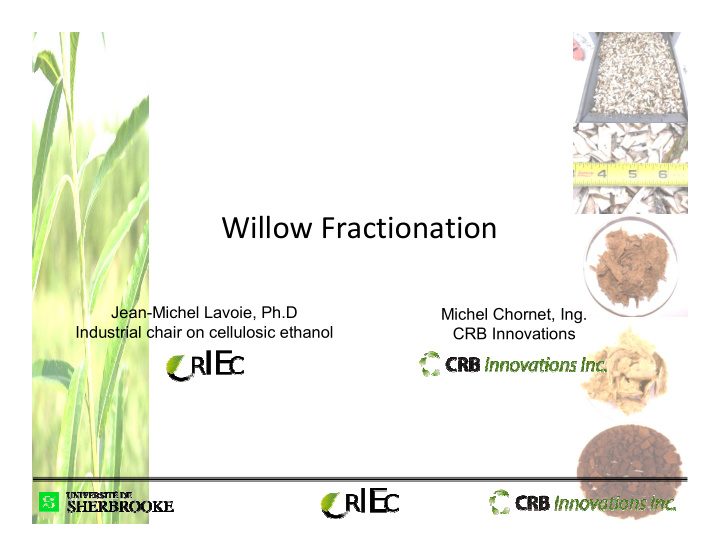



Willow Fractionation Jean-Michel Lavoie, Ph.D Michel Chornet, Ing. Industrial chair on cellulosic ethanol CRB Innovations
What is the target? • Willow energy crops (Agro Energie + IRBV) • Content: – Cellulose – Lignine – Hemicellulose – Proteins – Extractives • Objective - Upgrading the fractions – Green fuels and green chemicals
What is « fractionation »? • Using the FIRSST process: – Separation of the lignocellulosic matrix – Using steam treatments • The isolated fractions – Converted independently • The end products – Ethanol, biodiesel, biojetfuel, green compounds • Low secondary products, low CO 2 emissions
Process flow diagram Willow FIRSST Extractives Hemicelluloses Cellulose Lignin Proteins Hydrolysis Fermentation Anaerobic Fermentation Green molecules Mono Di-Tri Char Pharmaceuticals EtOH Gasification Jetfuel CH 4 CO 2 Feedstock Reforming C 5 sugars Intermediairy Catalytic End Product conversion Biodiesel Syngas
Ethanol from willow Swelling Hydrolysis Ferment. Distillation
Potential for willow Component Salix viminalis (1YO) Salix miyabeana SX67 Ashes 2 MU n.d. Extracts 8 MU 7 MU Hemicelluloses 17 MU 11 MU Cellulose 47 MU 53 MU Liginin 30 MU 28 MU
Ethanol/green chemicals • From 1 tonne of Salix viminalis – 267 litres of EtOH – 83 litres of p-fuels (biodiesel) – 197 litres of l-fuels (bio jetfuel) – 40 kg of added-value molecules • From 1 tonne of Salix miyabeana SX67 – 304 litres of EtOH – 54 litres of p-fuels (biodiesel) – 184 litres of l-fuels (bio jetfuel) *Energy requirement – 40 kg of added-value molecules 13 GJ/tonne
Our approach Quasi-homogeneous biomass 1 tonne (dry basis) + 1 tonne moisture Green chemicals : 40 kg EtOH : 250-300 l Biofuels Biodiesel : 50-80 l FIRSST Water: 1017 kg Jetfuel : 180 l CO 2 : 252 kg Residues Solid residues (rich in N and K): 5 kg (216 kg dry basis) High pressure SG (216 0.84 MWh(t) + 0.7 MWh (e) Nm 3 ) for hydrogenation CHP For p-fuels and l-fuels Gasification Syngas CO 2 removal Water: 210 kg Solid residues CO 2 : 644 (<5% unconverted C) Steam/O 2 kg Non-homogeneous biomass 0.7 tonne (dry basis) + moisture
Our group • Strong partnership – Academia + industrial • Chair created in 2007 • Funded by four patners: – MRNF – Enerkem – Greenfield Ethanol – CRB Innovations
Acknowledgements • eco-ETI • Agro Energie + IRBV • MRNF – Québec • Enerkem • Ethanol Greenfield • NRCan • NSERC • ABIN Discussing research strategies at the Chair • Our staff and students
Recommend
More recommend